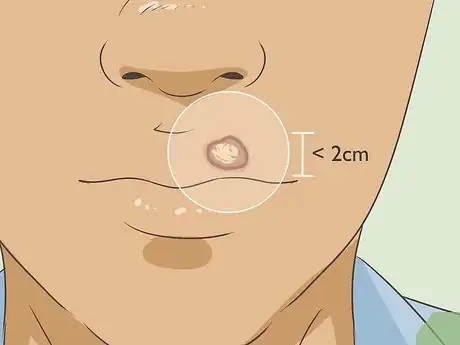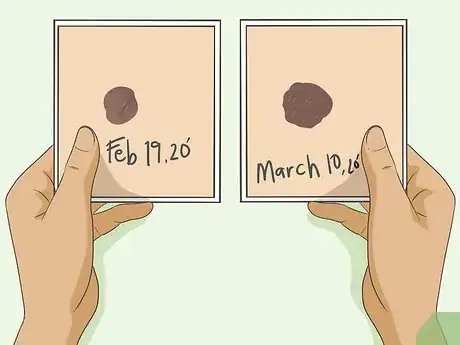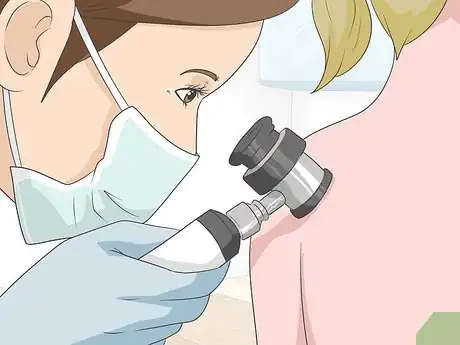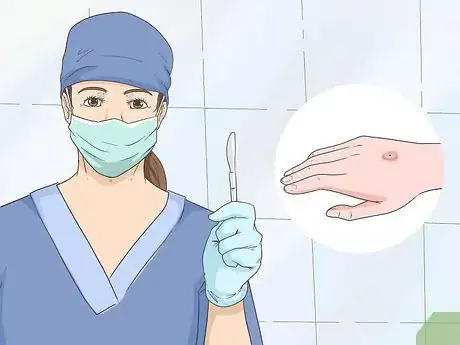This article was medically reviewed by Janice Litza, MD. Dr. Litza is a board certified Family Medicine Physician in Wisconsin. She is a practicing Physician and taught as a Clinical Professor for 13 years, after receiving her MD from the University of Wisconsin-Madison School of Medicine and Public Health in 1998.
There are 28 references cited in this article, which can be found at the bottom of the page.
This article has been viewed 798,454 times.
Early detection of skin cancer is important and can be lifesaving, especially for certain types of skin cancer such as melanoma and squamous cell carcinoma. It is estimated that 76,380 new cases of melanoma will be diagnosed in 2016 and over 13,000 will die from the skin cancer.[1] Given that timing is so crucial to diagnosing and treating skin cancer, you should follow a few simple steps to learn how to detect skin cancer on your skin.
Steps
Examining Yourself for Skin Cancer
-
1Perform a skin survey. The best way to check yourself for skin cancer is to do a self-examination, or survey. When performing your skin survey, choose a particular day during the month and note it on the calendar. Evaluate each area of your skin, leaving no part unseen. After you look at all the easily seen areas, use a mirror to evaluate the genitals, the anal area, between the toes, your back, and any other hard to see area. It may be helpful to have an image of a body chart and check off areas as you check them on yourself, as well as make note of any moles or markings you find.[2]
- For examining your scalp, enlist the help of a friend, partner, or spouse. Part your hair in small sections looking and feeling for erosions, scales, or discolored lesions.[3]
- With the advent of tanning booths and full-body tans, you can end up with skin cancer on the vulva and penis. Take your skin survey seriously and leave no surface unexamined. The best way to adequately perform this survey is to know what each different kind of skin cancer looks like.[4]
-
2Watch out for basal cell carcinoma. Basal cell carcinoma is the most common form of skin cancer. It is most often found in the sun-exposed areas of the head, including the ears and neck. It is erosive in nature, which means the local skin invasion of the cancer eats into the tissue it affects. It metastasizes, or spreads, to other sites on the body. Risk factors for this include sun exposure, tanning bed use, tendency to freckle, fair skin, number of blistering sunburns in your lifetime, and history of smoking.[5]
- The lesions are flat or slightly raised, pink or flesh-colored, bleed easily, and have a type of hole in them. They have appearance of eroded flesh and can look like a sore or lesion which oozes, crusts, and doesn't heal. The lesions typically range in size from 1 to 2 cm.[6]
Advertisement -
3Recognize the characteristics of melanoma. Early detection is especially important with melanoma. It is the most deadly of all skin cancers. Melanoma can be cured if it is caught early during stage one. As the cancer advances to late stage cancer, the survival rate for more than a few years is less than 15%. The skin lesions associated with melanoma have certain characteristics that can be looked for when checking yourself for skin cancer, which are based on an ABCDE scheme.[7]
- A stands for the typical asymmetry within the skin region, where one half does not match the other half.[8]
- You should also look for a Border, which will be irregular, ragged or notched, jagged, and not sharp or crisp.[9]
- The Color will also change across the skin area with a kind of tie-dye effect with blacks, browns, and blues.[10]
- You must also look for the Diameter of the lesion.[11] It will likely be larger than six mm, or just a bit over a 1/4 an inch in size.
- You will also notice the mole or lesion Evolve, or change, its appearance over time. [12] [13] [14]
- People with darker skin color must be aware that they are at risk for cancer as well — in particular a dangerous form of melanoma that is not caused by sun exposure, called acral lentiginous melanoma (ALM). It is typically found on the palms of the hands, soles of the feet, or even under the nails.[15]
-
4Notice squamous cell carcinoma (SCC). Squamous cell carcinoma starts out with a precancerous lesion called actinic keratosis (AK), which is a lesion that is not a cancer. An AK lesion appears as scaly flesh or a pink colored lesion and are most commonly found in the head, neck, and trunk of the body.[16] They are often rough or scaly to the touch. These develop into SCC lesions, which are small plagues that are raised, plateaued, and painless with smooth edges. There may appear alone or in clusters. They are typically less than 2 cm in size. They may itch, bleed easily, and appear as non-healing wounds that won’t go away but also don’t grow.[17]
- Lesions greater than 2 cm have a 10 to 25% chance to be aggressive and spread. The lesions most prone to spread are those that start on the nose, lips, tongue, ear, penis, temple, scalp, eyelid, scrotum, anus, forehead, and hands.
- In those with multiple AK lesions, the chances that at least one will go on to convert to SCC are between 6% to 10%.[18]
- There are several categories of people that are at risk for SCC, including those individuals with chronically injured or diseased skin. You are also at risk is you have overexposure to UVA or UVB rays, ionizing radiation, chemical carcinogens, and arsenic. You are also at risk if you have an infection with HPV viruses 6, 11, 16, and 18, leukemia or lymphoma, acne, or take immunosuppressant drugs.[19]
-
5Keep track of lesions. As you perform your body searches and notice any of the three different kinds of lesions, keep track of them.[20] Any suspicious lesion should be photographed and marked in red on your body map. When you do your exam the next month, look for changes. Take another picture and compare the two.
- If there are any changes, even subtle ones, follow up with your dermatologist. Bring your body map and photos to the appointment so you can show them exactly what has been going on.[21]
Diagnosing Skin Cancer
-
1Get clinical diagnosis. After you notice the lesions on your body, you need to have it clinically checked by a dermatologist.[22] This is so you can figure out they indicate skin cancer and, if so, which stage it has reached. Once the specific kind is determined based on your lesion's physical characteristics, your doctor will discuss your options with you, depending on your particular situation. The doctor may decide on surgical excision right away if it is certain that your cancer needs that. If the doctor is less certain, they may choose to perform a dermatoscopy, which is a procedure where the lesion is reviewed under high-powered microscope.[23]
- Keep in mind that there are many skin changes — including new and changing moles and lesions — that are not cancer. Only an experienced physician can evaluate and help you decide if further evaluation or treatment is needed, so always err on the side of caution and get checked out.
- Your doctor may also use a confocal scanning laser microscopy (CSLM), which is a non-invasive imaging study that provides pictures of the epidermis and the papillary dermis in real time. This will help distinguish benign from malignant lesions.
- Your doctor may also opt for a biopsy. Although it is a good test that is still used, a biopsy is not always 100% certain.[24]
- These techniques further allow your provider to recognize a melanoma and distinguish clinically between other difficult to diagnose lesions.
-
2Treat precancerous lesions. If you find that you have an actinic keratosis (AK) lesion, you need to treat it so you do not develop squamous cell carcinoma. If a single AK lesion exists, it is easy to treat; however, if you have multiple AK lesions, it may become less efficient and cost effective to treat them. Instead, you can just keep an eye on them. Observe the cluster of AK lesions for a while before you choose a method to remove them.[25]
- You can remove a singular AK lesion with cryotherapy, which is when the doctor freezes off the lesion with liquid nitrogen.[26] You can also choose electrodissection with curettage, which is the cauterization and removal of the lesion with a scalpel. You can also try laser resurfacing or the application of fluorouracil to remove a single lesion as well. [27]
-
3Take care of other skin cancers. The primary treatment for other skin cancers is surgical treatment. The doctor may perform a surgery where the tumor or lesion is cut out all of the diseased skin with clear surgical margins. Another popular surgical treatment option is Mohs surgery. This is a micrographic surgery that is used for non-melanoma skin cancer (NMSC), basal cell carcinoma, and squamous cell carcinoma.[28]
- These cancers grow in the localized area of the primary tumor, only occasionally metastasize; however, they can be locally aggressive and erode the local tissue and frequently recur. These are the carcinomas most often treated with Mohs micrographic surgery that ensure that a malignant focus is not left at the site of excision, which could be responsible for recurrence.[29]
-
4Prevent future skin cancer. In order to prevent future skin cancer, you can take some precautions to help protect yourself. Since sun exposure is the main cause of skin cancer, use a broad spectrum sunscreen with both UVA and UVB protection plus barrier protection on our most vulnerable areas when you go outside. These vulnerable areas are the head and neck. You can also wear a hat.[30]
- It is a common misconception that people with dark skin don't need to wear sunscreen. Use sunscreen and practice other sun-safe habits, regardless of skin color.[31]
- You should also avoid tanning beds.
- Remember that mucous membranes such as lips and tongue can be affected by SCC and become aggressive and spread.[32]
Expert Q&A
-
QuestionI'm 20 years old and notice many spots on my body, including my genitals, how to I know if it's cancer?
 Janice Litza, MDDr. Litza is a board certified Family Medicine Physician in Wisconsin. She is a practicing Physician and taught as a Clinical Professor for 13 years, after receiving her MD from the University of Wisconsin-Madison School of Medicine and Public Health in 1998.
Janice Litza, MDDr. Litza is a board certified Family Medicine Physician in Wisconsin. She is a practicing Physician and taught as a Clinical Professor for 13 years, after receiving her MD from the University of Wisconsin-Madison School of Medicine and Public Health in 1998.
Board Certified Family Medicine Physician Early sun exposure or tanning beds will increase the amount of freckles that will appear over time and with repeated exposure. You should focus on any that appear different from the rest, especially if changing rapidly or any of the ABCDE criteria mentioned above.
Early sun exposure or tanning beds will increase the amount of freckles that will appear over time and with repeated exposure. You should focus on any that appear different from the rest, especially if changing rapidly or any of the ABCDE criteria mentioned above.
References
- ↑ http://www.cancer.org/acs/groups/content/@research/documents/document/acspc-047079.pdf
- ↑ https://www.cancer.org/healthy/be-safe-in-sun/skin-exams.html
- ↑ http://www.skincancer.org/skin-cancer-information/early-detection/step-by-step-self-examination
- ↑ http://www.skincancer.org/skin-cancer-information/early-detection
- ↑ https://www.ncbi.nlm.nih.gov/books/NBK482439/
- ↑ Rajpara, Sanjay and Anthony Ormerod, Basal Cell Carcinoma, Am Fam Physician. 2008 Jul 15, 78(2): 248-250
- ↑ https://www.aad.org/public/diseases/skin-cancer/find/at-risk/abcdes
- ↑ Heather Richmond, MD. Board Certified Dermatologist. Expert Interview. 15 September 2020.
- ↑ Heather Richmond, MD. Board Certified Dermatologist. Expert Interview. 15 September 2020.
- ↑ Heather Richmond, MD. Board Certified Dermatologist. Expert Interview. 15 September 2020.
- ↑ Heather Richmond, MD. Board Certified Dermatologist. Expert Interview. 15 September 2020.
- ↑ Ferrris, Laura K. and Ryan J Harris, New Diagnostic Aides for Melanoma, Dermatology Clinical, 2012 July 30 (3) 535-545.
- ↑ Nikolaou, Vasiliki A., Alexander J. Stratigos, Keith T. Flaherty and Hensin Tsao, Journal of Investigative Dermatology, Melanoma: New Insights and New Therapies (2012), 132, 854–863
- ↑ Nikolaou, Vasiliki A., Alexander J. Stratigos, Keith T. Flaherty, and Hensin Tsao, Journal of Investigative Dermatology Melanoma: New Insights and New Therapies, (2012), 132, 854–863
- ↑ http://www.skincancer.org/prevention/skin-cancer-and-skin-of-color
- ↑ https://www.aad.org/public/diseases/skin-cancer/actinic-keratosis-overview
- ↑ https://www.aad.org/public/diseases/skin-cancer/types/common/scc
- ↑ https://www.aafp.org/afp/2012/0715/p161.html
- ↑ Alam, Murad and Désirée Ratner, Cutaneous Squamous-Cell Carcinoma, New England Journal of Medicine, 2001, 344, 975-983
- ↑ https://www.aad.org/public/diseases/skin-cancer/find/at-risk/mole-map
- ↑ http://www.skincancer.org/skin-cancer-information/early-detection/make-the-most-of-your-visit-to-the-dermatologist
- ↑ https://medlineplus.gov/lab-tests/skin-cancer-screening/
- ↑ https://dermnetnz.org/topics/dermoscopy#:~:text=Dermoscopy%20or%20dermatoscopy%20refers%20to,it%20easier%20to%20diagnose%20melanoma.
- ↑ Ferrris, Laura K. and Ryan J Harris, New Diagnostic Aides for Melanoma, Dermatology Clinical, 2012 July 30, (3), 535-545
- ↑ https://www.aad.org/public/diseases/skin-cancer/actinic-keratosis-treatment
- ↑ https://my.clevelandclinic.org/health/diseases/14148-actinic-keratosis
- ↑ Alam, Murad and Désirée Ratner, Cutaneous Squamous-Cell Carcinoma, New England Journal of Medicine, 2001, 344, 975-983
- ↑ https://www.cancer.gov/types/skin/patient/skin-treatment-pdq
- ↑ Finley, Eric M. The Principles of Mohs Micrographic Surgery for Cutaneous Neoplasia, Ochsner J., 2003 Spring, 5(2), 22–33
- ↑ https://www.cdc.gov/cancer/skin/basic_info/prevention.htm
- ↑ http://www.skincancer.org/prevention/skin-cancer-and-skin-of-color
- ↑ http://www.skincancer.org/prevention/sun-protection
About This Article
The best way to check yourself for skin cancer is to do a self-examination, or skin survey, to look for lesions or birth marks that might be cancerous. To do the survey, carefully inspect every area of your skin and use a mirror for any hard to see areas. Photograph any lesions or irregular moles and record their locations on a diagram of a body, or “body map.” Then, perform another exam after one month. If you notice changes in the color, shape, or size of any of the lesions or moles, follow up with a dermatologist for a clinical diagnosis. For more tips from our Medical co-author, including how to take care of skin cancers and precancerous lesions, keep reading!

















-Step-13.webp)

-Step-8-Version-3.webp)



















































Medical Disclaimer
The content of this article is not intended to be a substitute for professional medical advice, examination, diagnosis, or treatment. You should always contact your doctor or other qualified healthcare professional before starting, changing, or stopping any kind of health treatment.
Read More...